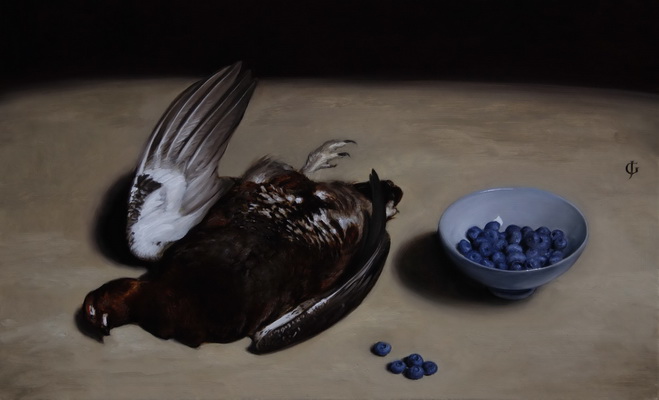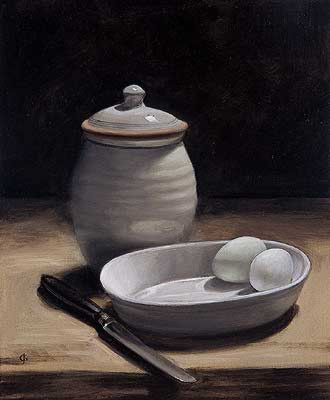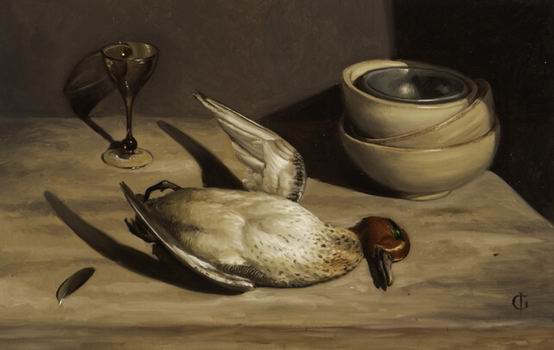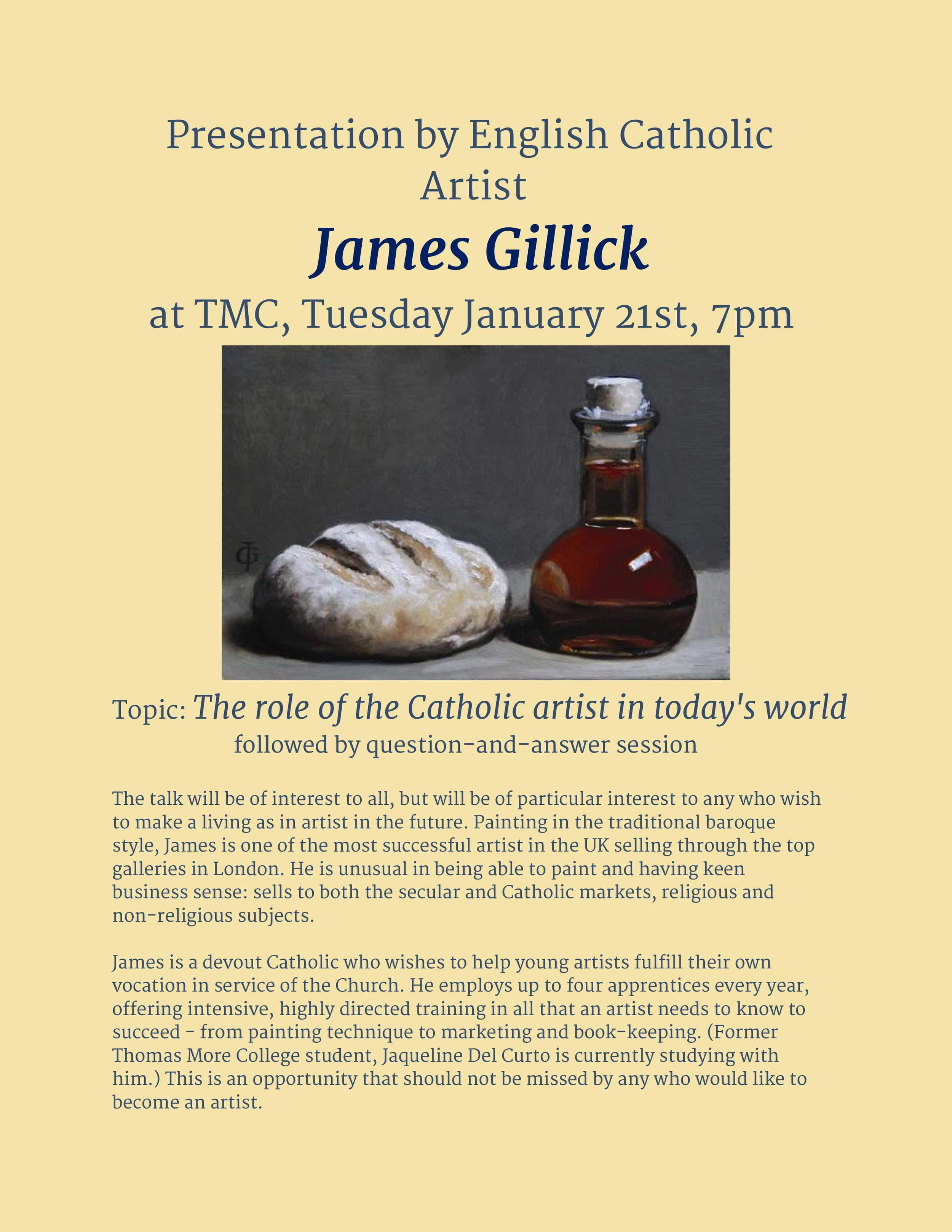What a small parish can achieve with good taste and the will to have a beautiful church, even with limited means. The art in the reredos is a variety of styles that blend. If I were to characterize them, I would say 17th-century style baroque, and Italian and Flemish style 15th century Renaissance style.
Lessons on How to Sell Beautiful Art to a Secular Market
English Catholic Artist James Gillick Speaking at Thomas More College on January 21st
 James Gillick one of the UK's most successful artists, will be speaking at Thomas More College in the library building at the campus in Merrimack, NH this coming Tuesday at 7pm. Jim, who is a good friend of mine and a devout Catholic, paints both mundane and sacred subjects. He is devoted to the re-establishment of a culture of beauty, not only through his own work, but by teaching. He offers up to four working apprenticeships a year. This is an intensive course in which apprentices are expected to work very hard. He teaches not only technique, but also the business skills of being an artist such as marketing and book-keeping.
His talk is open to the public and will be of interest to any who are interested in the arts, but will be of particular value to those who really want to make it as and artist. James is not precious about what he does - he has a refreshing, down-to-earth practicality about his work and the way he discusses it. He is based in Lincolnshire in England and sells through the top galleries in London.
James Gillick one of the UK's most successful artists, will be speaking at Thomas More College in the library building at the campus in Merrimack, NH this coming Tuesday at 7pm. Jim, who is a good friend of mine and a devout Catholic, paints both mundane and sacred subjects. He is devoted to the re-establishment of a culture of beauty, not only through his own work, but by teaching. He offers up to four working apprenticeships a year. This is an intensive course in which apprentices are expected to work very hard. He teaches not only technique, but also the business skills of being an artist such as marketing and book-keeping.
His talk is open to the public and will be of interest to any who are interested in the arts, but will be of particular value to those who really want to make it as and artist. James is not precious about what he does - he has a refreshing, down-to-earth practicality about his work and the way he discusses it. He is based in Lincolnshire in England and sells through the top galleries in London.
He is largely self taught (although he has the advantage of coming from a family of working artists) and his Catholicism informs his work - he consciously paints in the baroque style . I am particularly fond of his still lives.
When we look at any scene, we do not take it all in, in a single glance. Rather the eye, which has an angle of focus of only about 15 degrees roves around the scene, gathering information that is stored in the memory. We tend naturally to spend more time on those aspects of what is in front of us that we are most interested in and so we have most information about those areas. Those areas that are of less interest we pass over quickly. At any moment, the image on the retina of the eye has a central region that is in sharp focus, and has the greater colour. Peripheral vision is, in contrast, blurred and depleted of colour (the cells in that part of the retina can only transmit tonal information). The reason that we are not conscious of this is that the picture we see in our mind’s eye is supplemented by information given to it by the brain and which is supplied by the memory. If the memory does not have information about this particular scene, then the brain will supplement the picture, so to speak, with what it feels ought to be there based upon what has been seen in elsewhere. This is usually pretty reliable, but not always. (Illusionists manipulate this, for example, by tricking the mind to supply a picture of something that isn’t there.)
The naturalistic painting of the baroque period (the 17th century), developed a balance of focus and colour that mimicked this natural way of looking at things. The assumption behind it was that mankind is hardwired to appreciate the hand of the Creator in his creation and if the artist works in harmony with the way we see, then the well painted artwork will similarly, through its beauty, point us to the ultimate source of inspiration of the artist. Those areas that are of primary interest in the composition are rendered in sharper focus and contain more detailed information. Similarly, most of the painting, which the artist intends for us to see in peripheral vision is depleted of colour and rendered in monochrome (usually sepia). When this is handled skillfully the artist controls the passage of the eye over the canvas using the interplay of sharp contrast in tone and sharp edges, and supplies greatest detail and colour in those areas that are naturally of greatest interest. They are also the areas that contain most colour.
The academic method of drawing and painting, which was the basis of the baroque style, is gaining ground again, but this baroque balance of focus and tone is not always understood, and even more rarely properly applied. (I am likely to be making this point many times in this blog.) However, James Gillick (who interestingly did not learn his craft one of today’s ateliers of Florence or the US) is certainly someone who is pointing the way to something good for the future: his muted palette and sharp contrast of light and dark is sensitive to the methods of the Old Masters. You can see more of his work at www.gillick-artist.com .
Top Catholic Artist Offers Five Apprenticeships to Young Artists
 Catholic artist James Gillick has begun a formal scheme of apprenticeships at his studio in England. He will take on 5 people per year and is even building an extension to his studio in Louth, Lincolnshire in order to house his students. James works in the baroque style and sells through one of the leading galleries in London at top prices. He sell as an artist of both sacred and mundane subjects.
I have known James for some years now and he has always spoken to me about how he feels that artists don't seem to be aware beyond the basic skills of drawing and painting is his understanding of his market and that he wanted to be able to help people who wished to do this. For example, when he spoke to the students at Maryvale he would always play down the image of the sensitive artistic temperament. Rather, he likened what he did to the job of a bricklayer: 'A bricky gets paid on the number of bricks he lays,' said James. 'Similarly the artist gets paid for each painting he paints. If I am going to support my family, I must be able to paint quickly and to highest standard so that I have enough to sell. Then I have to find someone who is going to buy my paintings. If I don't do that we starve or I get job doing something else. I don't have the time to get precious about it.'
Catholic artist James Gillick has begun a formal scheme of apprenticeships at his studio in England. He will take on 5 people per year and is even building an extension to his studio in Louth, Lincolnshire in order to house his students. James works in the baroque style and sells through one of the leading galleries in London at top prices. He sell as an artist of both sacred and mundane subjects.
I have known James for some years now and he has always spoken to me about how he feels that artists don't seem to be aware beyond the basic skills of drawing and painting is his understanding of his market and that he wanted to be able to help people who wished to do this. For example, when he spoke to the students at Maryvale he would always play down the image of the sensitive artistic temperament. Rather, he likened what he did to the job of a bricklayer: 'A bricky gets paid on the number of bricks he lays,' said James. 'Similarly the artist gets paid for each painting he paints. If I am going to support my family, I must be able to paint quickly and to highest standard so that I have enough to sell. Then I have to find someone who is going to buy my paintings. If I don't do that we starve or I get job doing something else. I don't have the time to get precious about it.'
How he is helping directly by offering training and advice.
 He is looking for young people who want to, in his words, 'spend the next 50 years' being an artist. They will have to pay small up-front fee to cover room, board and materials (amounting to approximately $120 per week) but once they get going they will be paid for assisting him in the preparation of his canvasses and materials, preparatory painting work and assisting him in his business including liaising with his clients and galleries and book-keeping. By the end of the year they will be able to recoup this initial outlay through what they are paid for this work. Through working with him students will learn the life skills of being artist and be in a position to set up as sole traders. James sees this as much about forming the person to lead a hard-working, disciplined (and frugal) lifestyle as well as teaching them how to creating paintings. The will be pushed hard during this year. Artistically, depending on how experienced they were when they arrived, students can expect to be at a level where they can contemplate selling, or at the very least be in a position to develop their own work without being dependant upon spending years at an atelier in Florence. Some will probably stay and work with him longer than the year, but there are no guarantees here.
He is looking for young people who want to, in his words, 'spend the next 50 years' being an artist. They will have to pay small up-front fee to cover room, board and materials (amounting to approximately $120 per week) but once they get going they will be paid for assisting him in the preparation of his canvasses and materials, preparatory painting work and assisting him in his business including liaising with his clients and galleries and book-keeping. By the end of the year they will be able to recoup this initial outlay through what they are paid for this work. Through working with him students will learn the life skills of being artist and be in a position to set up as sole traders. James sees this as much about forming the person to lead a hard-working, disciplined (and frugal) lifestyle as well as teaching them how to creating paintings. The will be pushed hard during this year. Artistically, depending on how experienced they were when they arrived, students can expect to be at a level where they can contemplate selling, or at the very least be in a position to develop their own work without being dependant upon spending years at an atelier in Florence. Some will probably stay and work with him longer than the year, but there are no guarantees here.
Interestingly James, like my icon own teacher iconographer Aidan Hart, is largely self-taught. Both were able to do this by studying in such a way that they discerned at a deep level the principles behind the traditions they were working in. The training I was given by Aidan was not so much about how to paint icons (although clearly it did involve some of this) but more about passing on what I needed to understand so that I could train myself. This is what Jim will be doing with his students.
 This is an exciting development and I recommend young artists to consider this. He is looking for people who have the right qualities - self-discipline and preparedness to deal with the business side of being a succesful artist - as much as artistic talent.
This is an exciting development and I recommend young artists to consider this. He is looking for people who have the right qualities - self-discipline and preparedness to deal with the business side of being a succesful artist - as much as artistic talent.
Now that I am in the United States, I asked him about the possibility of training students from abroad. Jim said that he was certainly open to this - he was providing basic accomodation, so as long as they were prepared to travel to England he would take them on. He did note that the individuals would have to have to adapt the business elements to American situation once they left (for example, the regulatory aspects of establishing a business).
Enquiries should be made through his website www.gillick-artist.com/










